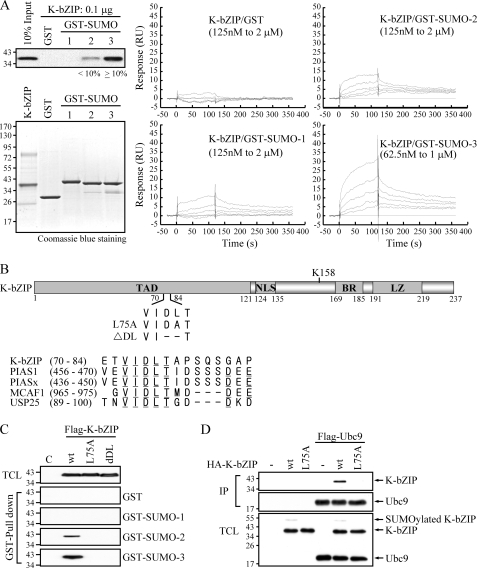FIGURE 1.
K-bZIP is a SUMO-2/3- and Ubc9-binding protein. A, left panel, direct binding of K-bZIP to SUMO-2 and -3 with a preference for SUMO-3. Baculovirus-expressed FLAG-tagged KSHV K-bZIP protein (F-K-bZIP) was incubated with glutathione-Sepharose beads (GST beads) bound to GST-SUMO-1, GST-SUMO-2, GST-SUMO-3, or GST. Equal amounts of GST proteins were confirmed by gel electrophoresis and Coomassie Blue staining (lower panel). The purified K-bZIP protein (10% of the input) was loaded in lane 1 (upper panel). Proteins were visualized by immunoblotting using anti-FLAG antibody. Right panel, Biacore analysis of interaction between K-bZIP and SUMO proteins. F-K-bZIP was immobilized to a CM5 sensor chip. GST, GST-SUMO-1, and GST-SUMO-2 were 2-fold serially diluted from 2 μm to 125 nm. GST-SUMO-3 was serially diluted from 1 μm to 65 nm. B, schematic representation of KSHV K-bZIP wt and its SIM domain mutant L75A (Leu-75 to Ala) or dDL (deletion of Asp-74 and Leu-75). Sequence comparison of K-bZIP SIM with previously identified SIM domains. TAD, transactivation domain; NLS, nuclear localization signal; BR, basic region; LZ, leucine zipper domain. C, wild-type K-bZIP, but not its SIM domain mutants, interacts with SUMO-2 and -3. TCLs of 293T cells transiently transfected with an expression vector encoding F-K-bZIP wt, or its SIM domain mutant L75A or dDL, were incubated with GST beads bound to GST-SUMO-1, GST-SUMO-2, GST-SUMO-3, or GST. Following incubation, the proteins associated with the GST fusion proteins were analyzed by immunoblotting using anti-FLAG antibody. Immunoblotting of TCLs confirmed equal transfection efficiency. D, wild-type K-bZIP, but not its SIM domain mutants, interacts with Ubc9. TCLs of 293T cells transiently transfected with an expression vector encoding HA-K-bZIP wt, or its SIM domain mutant L75A alone or co-transfected with FLAG-Ubc9 were incubated with anti-FLAG M2 beads. Following incubation, the proteins associated with F-Ubc9 were analyzed by immunoblotting using anti-K-bZIP antibody. Immunoblotting of TCLs using anti-FLAG and anti-HA antibodies confirmed equal levels of transfection efficiency.

